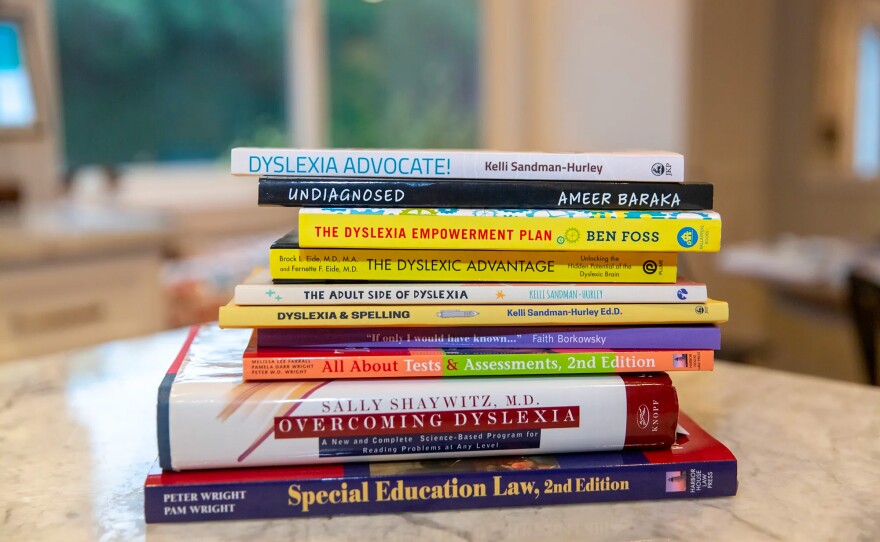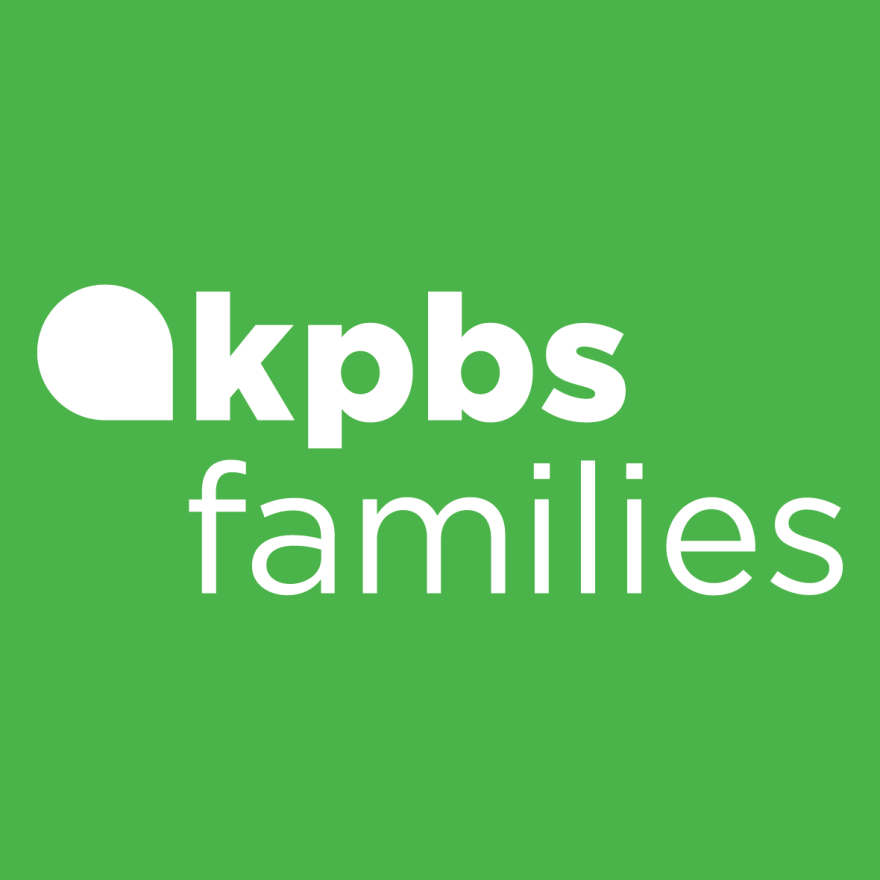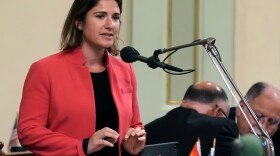State lawmakers plan to require that all students be tested for dyslexia and other reading challenges, but the hurdles ahead point to a bigger problem with how California’s public schools teach reading.
Before teachers can screen their students, they themselves need to be trained both in how to use the screening tests and how to help the students who get identified as struggling readers. Many experts and educators say most public school teachers in California weren’t adequately trained to teach students how to read.
“Nobody goes into teaching to mess up a kid’s life,” said Leslie Zoroya, a teacher coach specializing in literacy at the Los Angeles County Office of Education. “Teachers do think they’re teaching kids to read. But when you look at the data, it’s telling us that is not the case.”
Across the state, only about 42% of third-graders met or exceeded English language arts standards last year.
“Teachers do think they’re teaching kids to read. But when you look at the data, it’s telling us that is not the case.”Leslie Zoroya, a teacher coach specializing in literacy at the Los Angeles County Office of Education
The mandatory dyslexia screening policy was a part of Gov. Gavin Newsom’s revised budget proposal released last week, which allocated $1 million to form a panel of experts who would compile a list of reliable screening tools as well as determine the types of training needed for teachers. The proposal seeks to screen all students between kindergarten and second grade starting in the 2025-26 school year.
The policy proposal comes after several legislative efforts, spanning multiple years, to require dyslexia screening in California’s public schools. They failed largely due to opposition from the California Teachers Association. The statewide teachers union argued the practice of screening all students would disproportionately push English learners into special education and said the legislation needs to provide more resources for teachers.
The union did not respond to questions for this story about the types of support and training teachers need. But for some experts, the fact that teachers even need training to help students who struggle with reading illustrates just how far behind California is in literacy instruction.
“We’re going to need a lot more training,” Zoroya said. “This needs to be a statewide effort.”
The problem is twofold, according to experts. First, most of California’s public school districts use reading curricula based on “balanced literacy,” an approach to reading instruction based on the idea that children are natural readers. It relies on exposure to books and the enjoyment of reading with less of an emphasis on sounding out words. Second, the experts say, teacher preparation programs don’t train teachers enough in “structured literacy” or “the science of reading,” which focuses heavily on phonemic awareness and phonics — the practice of matching letters to sounds and sounding out words.
Betina Hsieh, the chair of the teacher education program at Cal State Long Beach, said balanced literacy curricula do include some phonics and argued that the balanced literacy approach works for most students.
“No one is saying that phonics and phonemic awareness is not important,” she said. “The thing is, it only gets you so far.”
But Hsieh agrees that all younger students should be screened for dyslexia and reading challenges and that teachers need to be trained. But she expressed frustration that there’s already so much material squeezed into teacher credentialing programs.
Zoroya argues that if teachers had been better trained in phonics instruction, dyslexia screeners would be a natural extension of their instruction. Because screeners test students’ ability to pair letters to sounds, a teacher who is adept in phonics will have an easier time navigating not just screening but helping students overcome their reading challenges.
“This work is too important for adults to be out here arguing,” she said. “We have too many kids coming out of elementary school not being able to read well.”
Too little phonics
Zoroya, who trains teachers across the 80 school districts in Los Angeles County, said most elementary school teachers don’t know how to teach reading through “structured literacy.” The approach’s focus on phonics enables students to sound out unfamiliar words.
Across California, students typically learn reading by being exposed to text and being read to in the classroom. Teachers focus on cultivating a love of reading as opposed to a more systematic instruction in letter sounds. While most students are able to learn reading through the former method, many are left behind. Dyslexia, a neurological condition that causes difficulty reading, affects about 1 in 5 people across the country.
According to experts, the fact that California is one of 10 states that doesn’t screen all students for dyslexia is a symptom of the broader problem of how public schools in the state teach reading. For educators, reading instruction remains hotly debated.
“It reminds me a bit of politics right now,” Zoroya said. “Even reading is very polarized.”
The debates over reading instruction have a deep and contentious history, which some refer to as “the reading wars.” In California, the “balanced literacy” approach came out on top in the reading wars. But teachers and parents across the country have spoken out against it, calling it a well-intentioned but fundamentally misguided way to teach reading.
Santiago Cuevas, a first grade teacher at San Francisco Unified’s Lafayette Elementary, said he received hardly any training in phonics instruction while earning his credential at San Francisco State University. He had to study the concepts of the “science of reading” on his own to pass the Reading Instruction Competence Assessment, one of the requirements for a teaching credential. The assessment tests prospective teachers’ ability to develop a reading curriculum, ranging from phonics to reading comprehension.
Cuevas said he was lucky to get hired at a school that happened to be committed to teaching phonics. But for most other teachers, the material they studied to pass the reading instruction assessment becomes an afterthought because their districts use balanced literacy.
“The RICA is just one of the things on the checklist to becoming a teacher,” Cuevas said. “It’s kind of strange how we didn’t talk about the science of reading at all at SF State.”
“In some ways, it feels very comfortable to primary grade teachers who say their students will catch up later. So it can be very uncomfortable when we put a universal screening measure in place.”Margaret Goldberg, literacy coach in West Contra Costa Unified
Margaret Goldberg, a literacy coach in West Contra Costa Unified, said not only are most teachers using faulty curricula, they’re also not assessing their students enough between kindergarten and second grade. Statewide literacy data is only available starting in third grade. But because students show signs of reading challenges as early as kindergarten, teachers need to take reading instruction seriously as early as age 5, she said.
“In some ways, it feels very comfortable to primary grade teachers who say their students will catch up later,” Goldberg said. “So it can be very uncomfortable when we put a universal screening measure in place.”
That discomfort materialized in the fight to mandate screening for dyslexia in California. The California Teachers Association, the state’s largest teachers union, opposed the proposed policy for multiple years despite a chorus of literacy experts calling for early screening for all students. The union said the legislation lacked details around what types of training teachers would need and how often students should be screened.
Cuevas said teachers who are more comfortable with phonics and the science of reading will be much more comfortable screening students.
He said, for example, if a student had a hard time saying the word “chair,” the balanced literacy approach would recommend just giving that child more books about chairs. But a teacher with training in structured literacy and phonics instruction has a more systematic approach that includes more testing and targeted instruction.
“It just seems like everyone’s trying to kick the can down the road,” Cuevas said. “With the science of reading, you just think differently.”
A necessary change
Goldberg and Cuevas agree that teachers, even those supportive of balanced literacy, have the best intentions. But they said that the shift toward mandatory screening should be accompanied by a shift toward more phonics instruction.
Goldberg said teachers first need to understand why screening matters. She said teachers typically see assessments as punitive and burdensome, but tests used to detect dyslexia and other reading challenges are a tool for improving instruction. Teachers might not understand why the tests ask students to sound out nonsense words, but Goldberg said sounding out random clusters of letters is the best way to detect whether a student will struggle with reading.
“They seem like arbitrary tasks,” she said. “Once you understand why each measure is important, administering the screeners is actually quite simple.”
School and district administrators also need to embrace these shifts. Meghan Trutter, a reading intervention specialist in the San Jose area, said teachers who learn about the science of reading later in their careers often tell her “this is what I needed all along.”
But Trutter said she’s concerned about whether districts will support teachers with the right curricula once the state mandates screening. If teachers aren’t given the necessary textbooks and materials to teach phonics, screening will be a pointless exercise.
“If the district executives don’t get it, they’re going to be another roadblock,” she said. “I can see teachers saying ‘We’ve identified the problems, now what?’ The district might say ‘I don’t know.’”
However, educators say there’s some much needed changes coming to teacher credentialing programs. A law signed in 2021 requires programs to teach the science of reading approach by 2025.
“I believe new teachers that are coming out of these programs are going to be better equipped to teach students how to read,” said Mara Smith, a reading specialist with the L.A. County Office of Education who helped revise California’s standards for teacher credentialing.
Long-term obstacles
The overhaul necessary in higher education will be easier said than done, according to some professors. Hsieh, at Cal State Long Beach, said one issue is the segregation of special education and general education programs.
She said prospective teachers in general education programs don’t get the training they need in phonics because those skills are more intensely taught in special education programs that focus on working with struggling students.
Another problem is the short length of teacher training programs. Elementary and middle school teachers earn the same multiple-subject credential. Their training spans instruction for kindergarten through eighth grade. Hsieh says this leaves little wiggle room for changes to teacher-training curricula.
“We’re working on being flexible and adaptive, but it’s challenging,” she said. “There’s so much that’s being demanded of teachers.”
And it’s not just classroom teachers and district administrators who are entrenched in balanced literacy. Most professors teaching in California’s credentialing programs are also committed to the approach, according to Kathy Futterman, a professor at Cal State East Bay. She said most professors aren’t sufficiently trained in structured literacy.
“I don’t know how many professors and instructors have themselves mastered structured literacy,” she said. “I feel like I’ve been swimming upstream and swimming solo for a long time.”
Futterman said the push for structured literacy as well as for mandatory screening started as a grassroots movement among parents and classroom teachers. But without a more systemic transformation, reading instruction in California will remain a patchwork, she said.
“We are heading in the right direction,” Futterman said. “Now we have to make sure everybody can be on board.”







